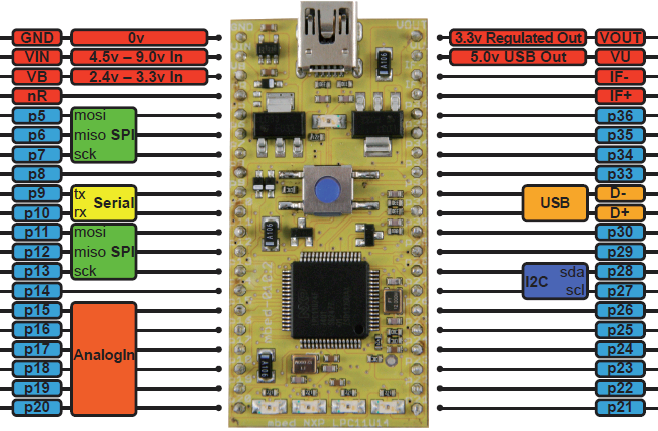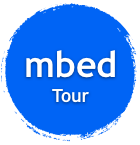You are viewing an older revision! See the latest version
mbed NXP LPC11U24
Rapid Prototyping for USB devices, battery applications and low-cost 32-bit ARM® Cortex™-M0 based designs

Overview¶
The mbed Microcontrollers are a series of ARM microcontroller development boards designed for rapid prototyping.
- Find out more about all mbed Microcontrollers
The mbed NXP LPC11U24 Microcontroller in particular is designed for prototyping low cost USB devices, battery powered applications and 32-bit ARM® Cortex™-M0 based designs. It is packaged as a small DIP form-factor for prototyping with through-hole PCBs, stripboard and breadboard, and includes a built-in USB FLASH programmer.

The mbed Microcontrollers provide experienced embedded developers a powerful and productive platform for building proof-of-concepts. For developers new to 32-bit microcontrollers, mbed provides an accessible prototyping solution to get projects built with the backing of libraries, resources and support shared in the mbed community.
Features¶
- NXP LPC11U24 MCU
- Low power ARM® Cortex™-M0 Core
- 48MHz, 8KB RAM, 32KB FLASH
- USB Device, 2xSPI, I2C , UART, 6xADC, GPIO
- Prototyping form-factor
- 40-pin 0.1" pitch DIP package, 54x26mm
- 5V USB, 4.5-9V supply or 2.4-3.3V battery
- Built-in USB drag 'n' drop FLASH programmer
- mbed.org Developer Website
- Lightweight Online Compiler
- High level C/C++ SDK
- Cookbook of published libraries and projects
Tools and Software¶
The mbed Microcontrollers are all supported by the mbed.org developer website, including a lightweight Online Compiler for instant access to your working environment on Windows, Linux or Mac OS X.
- Find out more about the mbed Online Compiler
Also included is a C/C++ SDK for productive high-level programming of peripherals. Combined with the wealth of libraries and code examples being published by the mbed community, the platform provides a productive environment for getting things done.
Examples¶
The mbed NXP LPC11U24 Microcontroller is particularly great for building USB devices.
Example: USB Mouse
You can programatically send movement, button clicks and states, scroll the scroll wheel, and of course do this dependant on any sensors or logic you like. The absolute version of the mouse, allows developers to navigate to precise locations on the screen - great for interaction with program interfaces.
See USBMouse in the handbook
Example: USB Keyboard
In this example, we're sending media keys to control a PC media player, but you could of course type strings or send interesting keycode combinations and sequences.
See USBKeyboard in the handbook
You can find more USB examples on our USBDevice page
Example: Low Power
Here the LPC11U24 is put to sleep and woken up by a button to increment and update a display before returning to sleep. The board is running off two AA's cells and drops to couple of milliamps when not is use.
Schematics and Data Sheets¶
mbed NXP LPC11U24 Microcontroller
NXP LPC11U2x MCU
